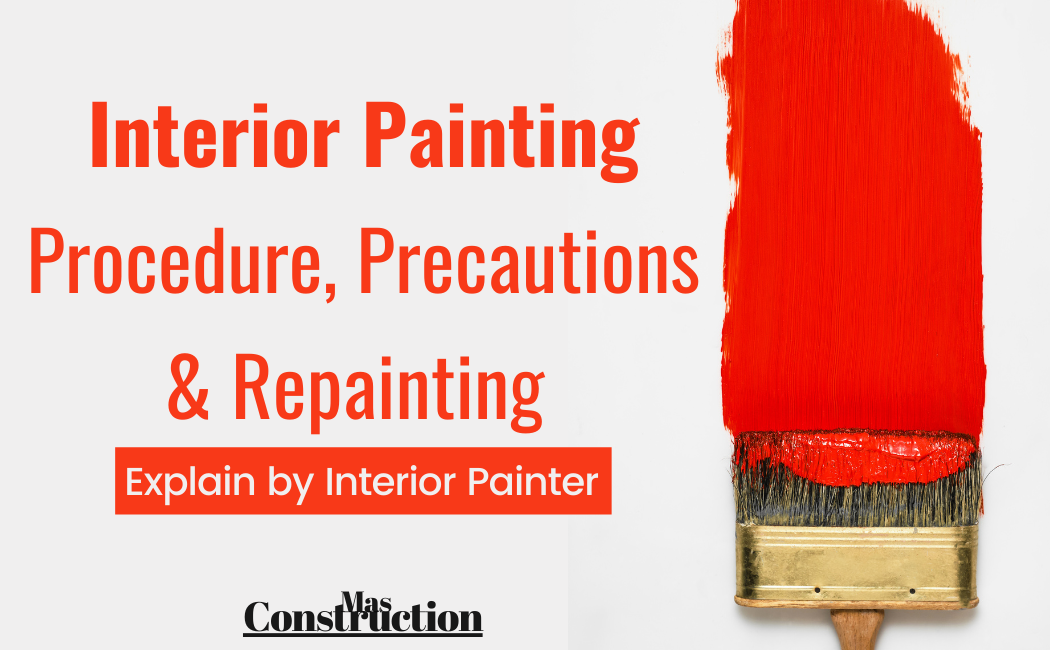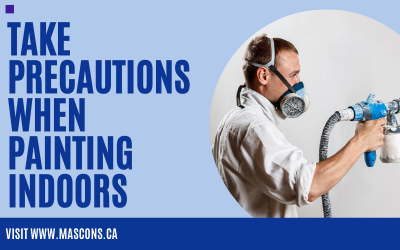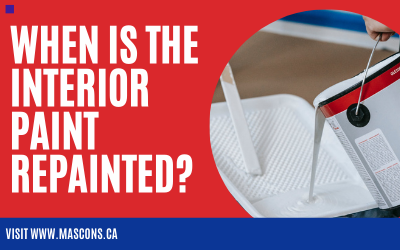Interior Painting Procedure, Precautions & Repainting – by Interior Painter

Mostly people are choosing an interior painting to renovate the walls of their rooms rather than wallpaper.
Here, I would like to explain the procedure and precautions for indoor painting by a professional Interior Painter in Toronto.
If you are considering changing the image of your room, please refer to it.
In This Article
- Features of interior painting
- Inner wall painting procedure
- Precautions when painting indoors
- When is the interior paint repainted?
- Precautions for paint used for interior painting
- If you want a more beautiful finish, Contact Mas Construction
Features of interior painting

If you have essential tools such as brushes and rollers, you can easily follow some steps.
On the other hand, with painting, you can easily repaint only the dirty parts.
One of the advantages of inner wall painting is that it is easy to repair. However, it is challenging to enjoy complicated designs because it is painted in a single colour.
Interior painting may be suitable for those who want a simple and stylish interior.
Inner wall painting procedure by Interior Painter
If you don’t take the right steps, you’re more likely to fail.
Therefore, I will introduce the procedure for actually painting the interior.
STEP1: Base treatment
Before painting, it is necessary to clean the groundwork. If the base is not flat, the finish will not be beautiful no matter how good the painting is.
If you see dents or steps on the wall, use putty to flatten it. If the wallpaper is peeling off, it is also necessary to repair it with a special adhesive.
In addition, it is also important to remove dirt to improve the paint finish.
You only need to wipe it with a rag, so be sure to remove any dirt before painting.
STEP2: Curing
Curing refers to protecting the unpainted areas. If this curing is performed, the paint will adhere to unnecessary parts, and the appearance will be dirty.
There is also a risk of soiling furniture. However, if you use a masker, you can easily cover various parts just by applying the tape.
In addition, apply masking tape at the boundary of the painting. If this tape is applied straight, the boundary between the paints will be a beautiful straight line.
Curing is a work that is directly related to the result of painting, so please do it carefully without cutting corners.
STEP3: Painting
After curing, it is finally the painting process. You can finish it more beautifully by applying it twice.
As time permits, try to anticipate two coats. Interior Painter recommends first to apply the difficult-to-apply corners with a brush and then apply the entire surface with a roller.
It is also important to apply the paint evenly to the rollers. For that purpose, it is also important to mix the paint well at the beginning.
Also, if you apply it twice, you need to dry it properly before applying it again.
If it is half-dried, it will cause uneven coating, so be sure to dry it before starting work.
STEP4: Dry
When the painting is complete, it is dried to complete. Remove cure before the paint dries.
If you forget to remove the curing, the paint may be peeled off together with the curing.
In the case of indoor painting, it will surely dry if it is dried for a day.
Precautions when painting indoors

In addition to the correct procedure, there are other precautions to be taken when painting the interior.
Ventilation
Ventilation is essential because the paint has a slight odour. If you work without ventilation, you may feel sick.
Interior Painter doesn’t use it much for indoor painting, but oil-based paints have a strong odour and can be addictive.
Well-ventilated and well-ventilated will help dry quickly.
Ventilate well to make the paint look more beautiful.
Best to do on a sunny day
The paint used for inner wall painting affects drying if the temperature is too low.
Also, if the humidity is too high, it will be hard to dry it fast, and the finish will be adversely affected.
Therefore, it is best to paint on a sunny day. In addition, ventilation will be easier on sunny days.
Forcibly painting on a rainy day will only dry the room and make the room unusable.
Be careful of thick coating
There is an appropriate film thickness for paint. If it is too thin or too thick, the function will be halved.
For DIY, it’s unlikely that the paint will be too thin unless you dilute the paint.
Rather, the problem is that the paint film is too thick. If the coating film becomes too thick, it will delay drying and cause cracks.
If the paint film is likely to thicken with sticky paint, it may need to be adjusted with a diluting liquid.
Adjusting the viscosity is difficult, so choosing an easy-to-handle paint is also important for DIY.
After the recoating is dry
When recoating, it is necessary to wait until the undercoat is completely dry before recoating.
If it is not sufficiently dried, it will be in the same state as a thick coat, and there is no point in recoating it.
Interior Painter explained earlier that if you apply too thickly, problems will occur.
When recoating, it is possible to achieve an even appearance only by recoating on a properly dried surface.
If you apply it in two parts, you need to dry it enough to be applied beautifully.
Mix well so that the paint is even
The paint is not always uniform as it is bought. Perhaps the pigment has sunk to the bottom.
Therefore, mix paint properly before use. For example, if you shake it well before opening it, you can mix the paint without splashing around.
In the first place, if the paint is uneven, unevenness will occur no matter how good the paint is.
Don’t forget to mix the paint to make it beautiful and even.
When is the interior paint repainted?

Compared to exterior wall painting, interior painting is almost unaffected by ultraviolet rays. Did you know when is the Right Time to Repaint the House?
Since deterioration is not a concern, you will be concerned about dirt and paint in most cases.
The room is a space where people live every day, so it gets dirty by all means.
You can’t live without getting dirty at all because you can get dirt on your hands just by touching it.
Of course, if left unattended for decades, the deterioration may be noticeable.
However, before that, the dirt will worsen, so I think it’s a good idea to repaint according to the degree of dirt.
Precautions for paint used for interior painting
There are numerous types of paints available for house painting in Toronto.
If you go to a home improvement store, you may be overwhelmed by the variety.
It is not just a matter of choosing what you like about painting.
Sometimes the right person is in the right place for paint, so it is necessary to examine the appearance and function.
When selecting paints for interior wall painting, pay particular attention to the following points.
Choose water-based paint
The first thing to worry about when painting the inner wall is the effect of the paint on your health.
Some paints use dangerous solvents, so making the wrong choice can be irreparable.
All paints that use dangerous solvents are oil-based.
Therefore, it is important to first select water-based paint as the paint for indoor use.
Unlike the outer wall, the interior is a space where people live directly, so be sure to choose harmless paint.
Choose the paint that suits the place you want to paint
As I mentioned earlier, paint has the right material in the right place; paint is being developed for each place to be painted.
If you want to paint on cloth, you have painted for cloth, and if you want to paint on plaster walls, you have painted for plaster walls.
If you make a mistake in this selection, the paint may come off quickly or cause problems.
For example, in the case of cloth made of vinyl chloride, the plasticizer contained in the cloth causes the paint to become sticky.
In such cases, special paint or primer for vinyl chloride is required.
When choosing paint, you must first choose a paint that matches the material you are painting.
If you want a more beautiful finish, Contact Mas Construction

Interior wall painting is a relatively easy DIY, but it is still difficult for an apprentice to do it perfectly.
To make your house interior beautiful, it is necessary to paint evenly and evenly.
That’s why it is important to consult an Interior Painter Toronto? Because they are professionally experienced and skilled finish it much more beautifully than DIY.
Hiring a professional painter is hassle-free and guarantees quality work. Contact today the professional Interior painter in Toronto – Mas Construction, call us at 647-835-0590 get you free today.
